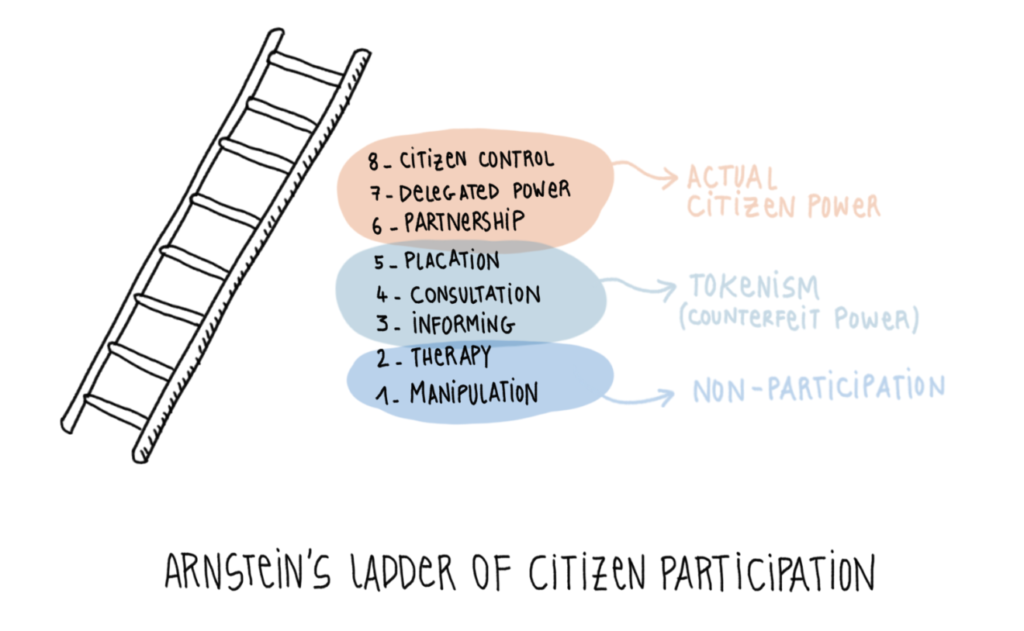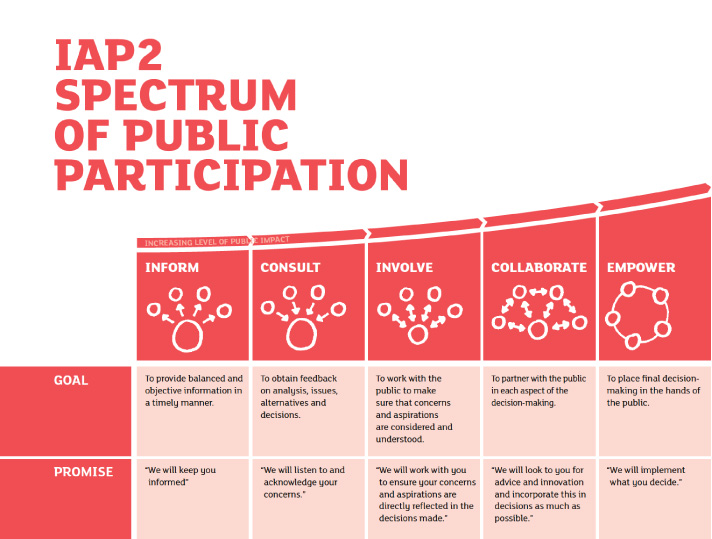There is no question that the built environment has an important effect on perception of security. Urban interventions to foster security are appealing for their simplicity and may be effective for surface-level problems. However, the success of public policies or transformations of the physical space can be short-lived if they are not accompanied by actions aimed to the restoration of the social tissue. The roles of city dwellers and city-scale policies have been re-evaluated as necessary to provide safety for all. The implementation of BSFS has given way to several observations on these subjects that are presented here.
What is citizen participation?
Citizen participation is a set of mechanisms for the public to express opinions and have an impact on decisions on various topics. Participatory processes have gained attention in projects of urban design, community development, and security. In France, participation became an essential element in public policy and the production of public spaces since the 1970s and 1980s.
The degrees in which city dwellers can get involved vary. In her book “A ladder of Citizen Participation” (1969), Sherry Arnstein groups the different levels of participation in three categories:

- citizen power: power holders and citizens create partnerships to share planning and decision-making responsibilities, their input is heard and leads to change, and/or the final say is left in the hands of the citizens.
- tokenism: participants are informed or consulted about an initiative; they may give input on the matter. However, this input will not have an effect on the end result.
- non-participation: a substitute for genuine participation – project managers are completely in control of the decisions.
Since then, the International Association of Public Participation (IAP2) has built upon this theory to develop the Spectrum of Public Participation

Participation can lead to a better appropriation of projects by city dwellers, as well as allowing authorities to improve on the durability over time. Researchers have identified that social engagement is essential to the durability and effectiveness of strategies aimed to tackle urban violence, not only in the form of crime. There have been efforts to re-introduce the social dimension into the spatial strategies to prevent crime, since this angle is not new, but interest in it has varied over time.
How is citizen participation useful to address insecurity?
Citizen participation to address crime and violence can be used to
a) diagnose the problem
b) co-create solutions to the problem
Traditionally, to diagnose a problem of insecurity, policy makers observed crime rates, and based on quantitative information, they defined a strategy and implemented it -all of this without input from the community. Integrating participation to diagnose a problem involves reaching out to the community. Activities such as in-depth interviews, exploratory walks, and discussion groups can be carried out to understand how the average city dweller perceives a given problem. This is especially important for security, since the perception of security is linked to the personal experiences, many of which are not just crimes. Qualitative data is just as valuable. It is recommended to work in small groups.
Once a problem has been adequately diagnosed, a solution can also be proposed with the participation of the target population. Work groups, collaborative workshops, hackathons, online consultations are ways in which this co-production can occur. Once again, this is a shift from top-down projects, where an authority decides what is the best course of action.
Certainly, city dwellers are not experts in all topics. The purpose of participation is not to delegate what should be the responsibility of authorities. While the city or policy maker has expertise on a given subject, it can be complemented with the empirical knowledge and perception of everyday life that the average city dweller has. Project managers require special sensitivity to keep matters focused while also being able to translate city dwellers’ opinions into strategies. Participation can therefore bridge the divide between the professionals and the target community.
Challenges of citizen participation
We can agree that citizen participation is necessary to improve security in cities: it gives project managers first-hand information about what problems are identified by city dwellers and their priorities, and produce solutions that are more effective, inclusive, and long-lasting. However, this is easier said than done. As many project managers can tell from experience, getting citizens to participate is not easy: sometimes citizens do not participate, and other times those who participate are always the same. Citizens can take the opportunity to express their grievances unrelated to the purpose of the participatory activity, and city makers do not know how to translate discussions into insight for decision making. And when it comes to security, The experience can be frustrating for everyone involved, particularly when it concerns a very sensitive topic such as security.
While citizen participation is all about openness, not all people are equally invested. Why some groups are more engaged than others? One element that explains this is victimization. Individuals who have had experiences of victimization are more likely to be involved in citizen-led initiatives or groups. In these groups, individuals connect with others who share the same worries and experiences, such as a neighborhood watch.
Yet…victimization is not the sole factor that motivates or deters participation. Tim Hope, a researcher from the University of Chicago, conducted a study in the 1990s to analyze community-based crime prevention strategies in the United States and Great Britain. In it, he observed the profile of those city dwellers that were involved in collective action: members of groups were less likely to come from poor, crime ridden communities, where there are high levels of suspicion. He proposed that the success of this approach would better be identified in relation to the “vertical” dimensions of relations that connect local institutions to sources of power and resources in the wider civil society. Project managers wishing to create participatory activities should consider the community’s power -or lack thereof- to engage in collective actions and pay special attention to them. Hope says:
“The paradox of community crime prevention thus stems from the problem of trying to build community institutions that control crime in the face of their powerlessness to withstand the pressures toward crime in the community, whose source, or the forces that sustain them, derive from the wider social structure“
In many cases, decision-makers tend to focus on individuals and groups who express greater levels of fear in surveys. However, frequently those who are more likely to be heard and more likely to address authorities about it do not necessarily representative of a situation of insecurity. Additionally, insight over non-criminal issues may be interpreted as irrational -particularly those expressed by marginalized groups-, and therefore, less deserving of attention, when in reality they are often affected the most by insecurity. Yet, they have a real impact on the way inhabitants use, perceive, and even transform their environments.
| What city- and policy-makers can do? Consider that not all crime is reported, that not all violence is treated as a crime, and that small non-criminal actions (incivilities, for example) affect feelings of insecurity. Combine qualitative and quantitative methods. Work in small groups. Maintain a constant presence with the target population and territory. Collaborate with local actors that are well-acquainted with the spaces in question. Work with vulnerable or marginalized communities. |
Source: https://www.uia-initiative.eu/en/news/citizen-participation-empowering-city-dwellers-make-cities-safer





